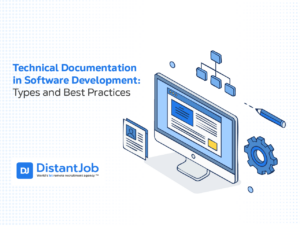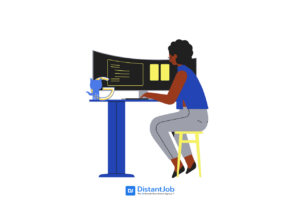The Coronavirus pandemic has forced many companies to transition to working remotely. Some of them, such as Twitter, have succeeded along the way. Others have struggled. A lot of team managers all over the world are finding themselves facing unknown micromanagement demons. And they are continually asking themselves: How do I know my employees are working if I can’t see them? Remote employee monitoring is now a hot topic, with SaaS solutions such as Time Doctor finding themselves struggling to meet demand.
But is monitoring remote employees really necessary? If so, what’s the best way to go about it. We’ve written a thing or two on the subject over the years, so here’s the DistantJob take.
Why Do You Want to Monitor?
Adjusting to managing a remote team can be difficult if you’re used to having your people in the same office or in nearby cubicles. When you’re in the office you can get a sense of how the team is working just by looking, and you can keep your finger on the pulse just by popping by someone’s desk. Now your team is all working from home, you’ve lost all that input, and that can leave you feeling like you’ve lost some control.
But here’s the thing: good workers are good workers, no matter if they’re in an office or at home. If you made good hiring decisions in the first place, then your team members are probably doing their jobs as well as they can under the current circumstances. So, do you need any additional monitoring just because they’re working from home?
Working Hours
These certainly aren’t the times to be monitoring the hours spent at the keyboard; presenteeism has been a problem for years, but when your staff is working at home during a pandemic, possibly juggling competing work schedules with their partner, or having to teach their children, is expecting them to work 9-5 really reasonable? One of the benefits of remote work has always been allowing your team to set their own work hours, letting them do their jobs at the time that best suits them and their work/life balance, at least as far as your business allows.

Believe it or not, there are remote employee trackers that allow the manager to ‘sneak a peek’ at what a team member is doing, either by mirroring their screen or a snapshot from the webcam. If that seems appealing, remember that remote teams thrive on an atmosphere of trust and nothing destroys trust quicker than knowing you are being spied on.
Participation
One area where some monitoring might come in handy is in the use of the new technologies that you’re using for your remote team. Take Zoom, for example; while many organizations are embracing the video conferencing tool, there are individuals who are reluctant to make it part of their working day. That might be because they’re set in their ways, or that they hate the idea of being on camera. Whatever the reason, using the ‘inactive users’ tool that Zoom provides can help you work out who may need extra support.
Zoom also offers the ability to ‘attention-track’ users; this means that you can notice whether someone has kept the meeting screen open and is completely focused or if they switched it to the background while they got on with other things. If you suspect your staff is doing this, rather than discipline them, it might be better to look at how to run better remote meetings or to understand that ‘Zoom fatigue’ is becoming recognized as a problem.

Work Product
Our preferred method for how to monitor remote employees is work product. If you are getting a satisfactory amount of work from each staff member, then does it really matter if they spend hours chained to their laptops or if they’re doing their best problem solving while they mow the lawn? You probably know what your team is capable of, so as long as the work is being completed to schedule, is there a problem?
Now, you might be hoping that your team is going to get the famous remote worker productivity bonus that you’ve heard so much about. You might see it, but do remember that we’re currently working under very unusual conditions and that the stresses and strains of quarantine may be taking their toll.
If you don’t already have a good task management solution for your team, then now is the time to get one. Choose something that allows your team to update you on their progress easily; whether that’s the completion of a task or that they’ve got roadblocked on something.
Speaking of roadblocks, one way to help keep your team motivated and ensure everyone is on the same page is a daily stand up meeting. If you use the Agile development methodology then you might already do this in the office, but you can still run standups either synchronously using a video call or asynchronously using a chat program. As long as everyone checks in with what they’re working on, what’s next, and what they need help on (if anything) your project should continue to make good progress.
The Downside of Trackers
One common complaint about remote work tracking software is that it can create an unnecessary admin burden on the employee. If telling people what you’re doing takes longer than actually doing it, then you have a problem! There are some tracking solutions that address this, most notably Timely which uses an AI to learn what your team is doing when they’re using certain documents or pieces of software and Tsheets, which lets your team switch from task to task with a single click.
But perhaps the most important consideration when it comes to productivity monitoring software for engineers or other technical staff is mental health. As we mentioned earlier, trust is a vital part of what makes a remote team successful, both having trust in your colleagues and knowing they trust in you. Be careful that in trying to monitor your staff you’re not destroying something more valuable than time.
In the current climate, we need to consider the mental wellbeing of our staff more than ever, and adding unnecessary admin burdens will not be helpful or conducive to a healthy working relationship. To quote our CEO, Sharon Koifman, ‘The management of your employee’s mental health is probably the biggest difference between a local environment and a remote one.’ Get to know your people, understand their pressures and their strengths, and work with them to set targets for production that you are both happy with.
Is Remote Employee Monitoring Really Necessary?
No matter what new solutions have come to market, we’ve always advocated for open communication, building trust, and measuring on results. If you’ve made the right hiring decisions, then that’s all you need to get great performance. And if you haven’t made the right hiring decisions? Contact us. We’d love to help connect you with a remote-ready Rockstar who’s raring to join your team.




